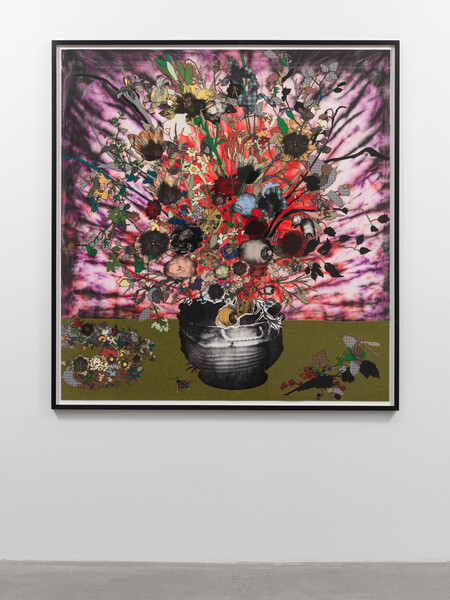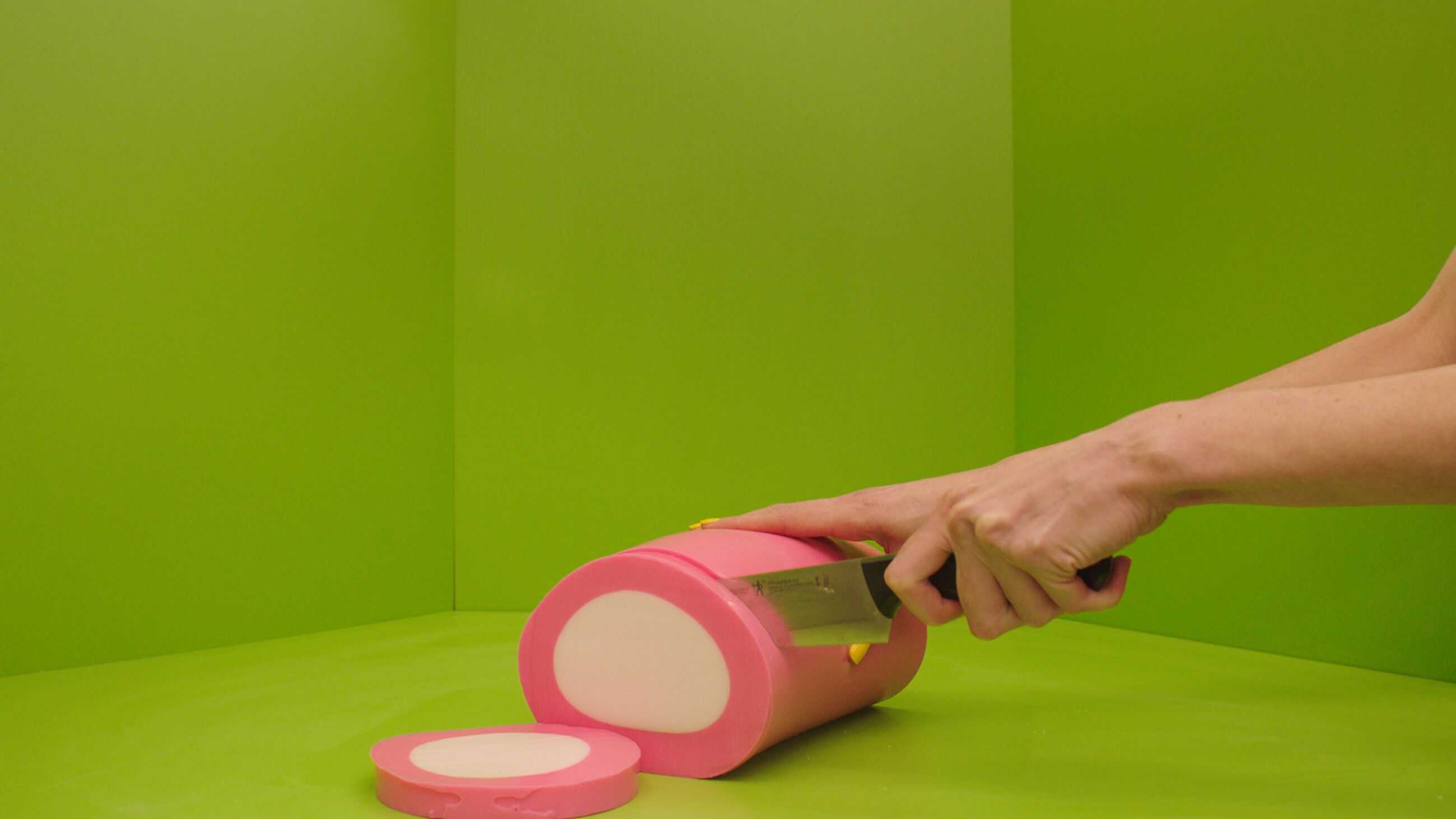Matthew Day Jackson

Matthew Day Jackson, Solipsist II, 2018, Formica, silkscreen, lead on panel, stainless steel frame © Matthew Day Jackson
Matthew Day Jackson
This resource has been produced to accompany the exhibition 'Matthew Day Jackson. Pathetic Fallacy’ at Hauser & Wirth Somerset from 19 January until 6 May 2019.
All group visits to Hauser & Wirth Somerset must be booked at least two weeks prior to arrival. Register your interest in a school booking here or contact the Education Team at education@hauserwirth.com. If you have questions or additional requests, please call our team on +44 (0) 1749 814 060.
About Matthew Day Jackson
Matthew Day Jackson is an American artist born in Panorama City, California in 1974. His multifaceted practice encompasses sculpture, painting, printmaking, collage, photography, drawing, video, performance and installation. He graduated with an MFA from Rutgers University in 2001, following his BFA from the University of Washington in Seattle. In 2009, Jackson obtained his NHRA License from Frank Hawley’s Drag Racing School, Gainesville FL.
Jackson lives and works in Brooklyn, NY and lived with his family as artist-in-residence at Hauser & Wirth Somerset from August 2018 - January 2019.
What are his main themes?
Jackson’s art grapples with big ideas such as how we relate to our constructed environment and our relationship our natural environment. In particular, the evolution of human thought, the fatal attraction of the frontier and the faith that man places in technological advancement. His work addresses the myth of the American Dream, exploring the forces of creation, growth, transcendence, and death, through visions of its failed utopia. The overarching concept is an interest in our compulsion to document, map, and systemise our natural world as a method for understanding nature.
What does his work look like?
Individual sculptures and paintings interconnect with each other to create complex scenarios that revisit history and reassemble its narratives. Jackson depicts these narratives using the world around him: scorched wood, molten lead, mother-of-pearl, precious metals, Formica, and found objects such as worn T-shirts, ceramics, axe handles and posters. Surface texture and sophisticated processes are central to Jackson’s art making.
These counterintuitive material juxtapositions resonate with symbolism, combining apocalyptic elements with the fruits of new technologies, historical imagery, homespun crafts and contemporary ingredients.
For Jackson, beauty is frequently partnered by desolation. His work explores a concept that he terms ‘the Horriful’; the belief that everything one does has the potential to bring both beauty and horror.

Matthew Day Jackson, Bouquet in a Sculpted Vase Beside a Wreath of Flowers (Berlin), 2018, Textile, silkscreen, architectural turf mat, pigment print on paper © Matthew Day Jackson
What inspires his work?
Jackson’s work occupies an intellectual terrain that reaches from ancient history to outer space exploration and discovery, finding inspiration in his natural surroundings and the people he meets. He utilises a familiar iconography, recycling culturally loaded images such as the geodesic structures of Buckminster Fuller, mankind’s first steps on the Moon, and the covers of LIFE magazine from the ‘60s and ‘70s, cross-pollinating these and mixing them with numerous references from art history, such as the Brueghel dynasty.
How does he title his work?
The title for Jackson’s exhibition ‘Pathetic Fallacy’ is a literary term used to describe the attribution of human emotions onto inanimate objects in nature. His continued investigation into society’s relationship with its natural environment haunts the exhibition, which is punctuated by collaborations with his family and the local community. To Jackson, the idea of ‘Pathetic Fallacy’ could also be about the impossibility of trying to capture and successfully depict such ideas.
How does he make his art?
Matthew Day Jackson works in sculpture, painting and printmaking; he actually studied printmaking at college. Jackson enjoys using unexpected non-traditional materials in making his art and enters into unlikely collaborations such as with the company Formica who produce a heat-resistant, wipe-clean laminate widely used in domestic houses since the 1920s, or with his own family.
Jackson’s Solipsist paintings are aerial views of colourful, silkscreened Formica landscapes, with satellites made of poured lead hovering in the space above. These works depict landscapes that are transforming due to human intervention. The works have been ordered into the four elements, with each wall of the gallery representing earth, air, fire and water.
The Mirror drawings are the counterpoint for the Solipsists and reveal the process used to sculpt the lead satellites. This partner series functions as a relic, offering the solipsist the tool to see its own reflection. The background is the night sky, again a counterpoint to the aerial land views in the Solipsists.
What other artists’ work does he relate to?
Matthew Day Jackson is interested in a wide range of subjects and artists. For this exhibition, he has cited some artists in particular from very different periods and genres such as Jan Brueghel, Rodin, Michelangelo, Käthe Kollwitz, and the Bauhaus movement, in particular Marcel Breuer’s, ‘Wassily Chair’.

Matthew Day Jackson, Solipsist XIV, 2018, Formica, silkscreen, lead on panel, oil paint, stainless steel frame © Matthew Day Jackson

Matthew Day Jackson, Mirror XIV, 2018, Scorched yarn, wood glue, sawdust, digital c-print on panel © Matthew Day Jackson
GLOSSARY
American Dream
This term is used to describe the set of ideals in which freedom includes the opportunity for prosperity and success, as well as an upward social mobility for the family and children, achieved through hard work in a society with few barriers.
Bauhaus
Bauhaus was a German art school operational from 1919 to 1933 that combined crafts and the fine arts, and is famous for its approach to design.
Brueghel dynasty
The Brueghels formed a dynasty — a complex family of artists spanning almost 200 years from 1525 onwards, innovating but also revisiting the work of previous generations to create an enduring ‘brand’ Brueghel.
Craft
Craft is a form of making which generally produces an object that has a function.
Dystopia
Refers to an imagined place or state in which everything is unpleasant or bad, typically a totalitarian or environmentally degraded one.
Narrative
A narrative or story is a report of connected events, real or imaginary, presented in a sequence of written or spoken words, or still or moving images, or both.
Satellite
In the context of spaceflight, a satellite is an artificial object, which has been intentionally placed into orbit. Such objects are sometimes called artificial satellites to distinguish them from natural satellites such as Earth’s Moon.
Solipsist
In philosophy, solipsism describes the extreme form of scepticism which denies the possibility of any knowledge other than of one’s own existence.
Technology
Technology can be the knowledge of techniques, processes, and the like, or it can be embedded in machines to allow for operation without detailed knowledge of their workings. The simplest form of technology is the development and use of basic tools.
Utopia
In opposition to dystopia, utopia is an imagined place or state of things in which everything is perfect.
SUGGESTED QUESTIONS AND ACTIVITIES FOR YOUR VISIT
NB. You will need to bring pencils and a sketchbook
Rhoades Gallery
Explore the space in small groups. Share your thoughts on what you have seen and how things may have been made.
Who uses satellites, what are they used for?
Can you name the four elements; can you see any relationships with the artworks on the walls?
Discussing the theme of the exhibition, appropriate to each age group, what do they understand of Pathetic Fallacy, American Dream, Utopia and Dystopia? This can be related to landscape and discussed in relation to the images and materials in the space.
How do you think the yew tree relates to the exhibition?
Look at the chairs; discuss what they are, what they represent and how they relate to each ‘Pieta’?
Layers: think about how the images are constructed, the process & composition. In groups choose an image and work out the best way to describe it in five sentences – feedback to the group.
Monoprint: create your own satellite image using the pre-prepared sheets.
Bourgeois Gallery
Moving in small groups explore everything in the gallery. Younger groups can do an ‘I-spy’ activity.
Inventing narratives: selecting an artwork in groups, invent your own stories (for example each member could contribute a line to a story).
The Kuumo is a hybrid character invented by the artist. ‘Exquisite Corpse’, a game invented by the Surrealists is a method of collectively assembling images. Select a subject inspired by the exhibition as the inspiration for a group character.
Discuss the flower prints: How are they made? How do they relate to art history? What makes them contemporary? What makes them traditional?
What does binary mean? How does the artist use binaries in these works and what is the result? Consider craft versus technology; home versus space; and body versus landscape.
Looking closely and using viewfinders, use drawing to record the motifs, textures and forms in the flower prints.
PRACTICAL ACTIVITY PROMPTS AND IDEAS FOR DISCUSSION FOLLOWING YOUR VISIT
Key Stage 1 and 2
What is it like on the Moon? Using found objects and discarded materials make the surface of the Moon inside a shoebox lid (or similar).
Depict the Earth as seen from the Moon. Use collage and painting techniques to create 3D relief satellite paintings. Cut out cardboard blocks of houses or streets to build up a map-like image and cover with paint to correspond with the artist’s visual language.
Key Stage 3 and 4
Artists, filmmakers and writers use dystopia to critique current society, can you think of some examples, e.g. The Maze Runner and The Time Machine. Create your own dystopian society based on one worrying trend that you see in the world, for example: that we use too much technology; plastics are destroying our planet; it is no longer safe to play outside; or businesses steal our personal data. You could write a story, make a painting or create a physical landscape. According to Beck, ‘his work is inspired by a similar belief [to the artist Borges] in art’s power to build worlds that become realities complex enough to change the world they inhabit’.
Discuss how different artists have represented war. For example, look at Goya, Picasso, Sutherland and McCullin.
Resources
1 / 10









